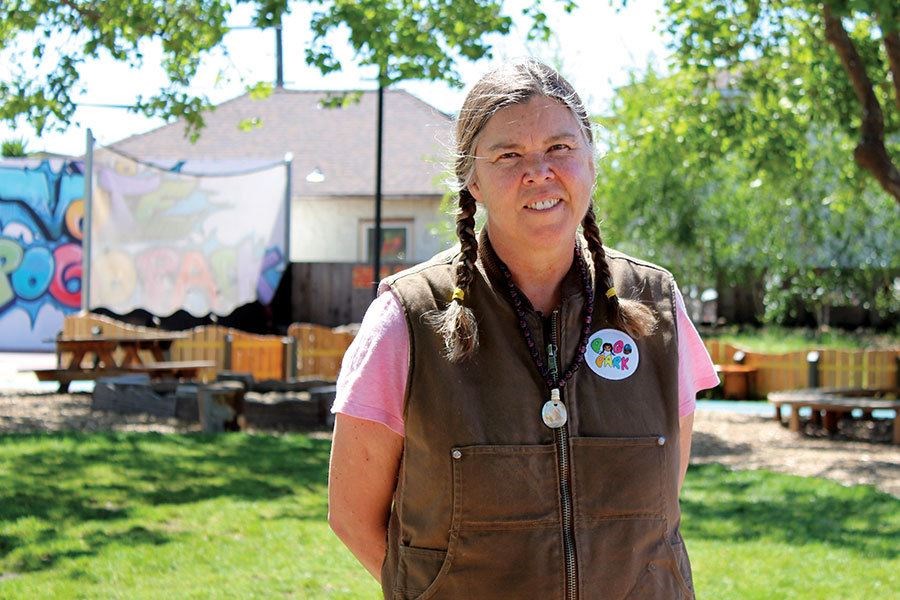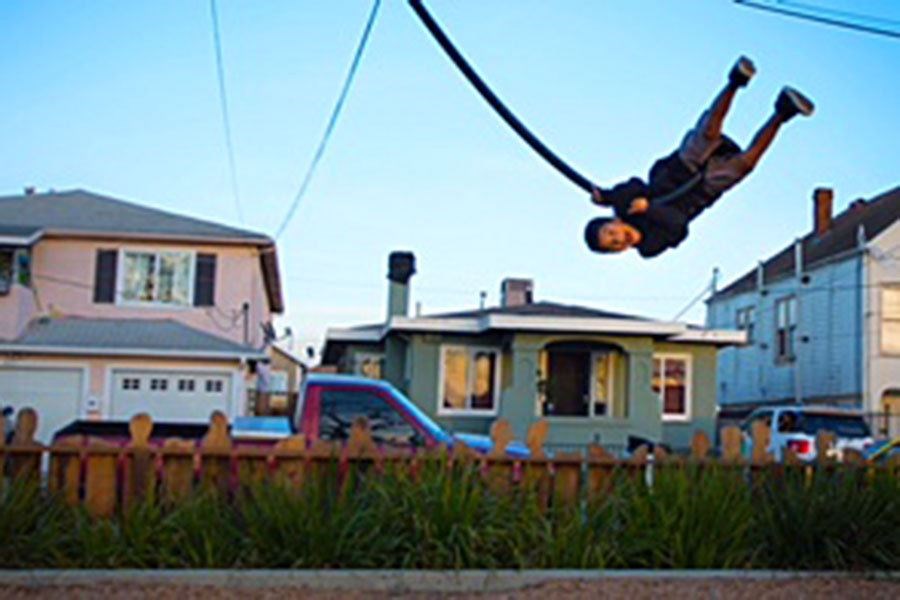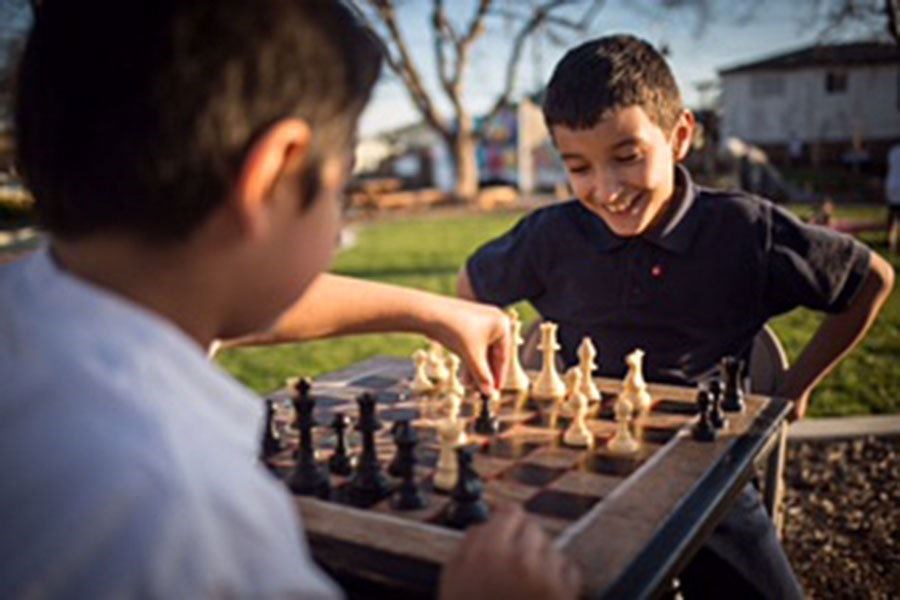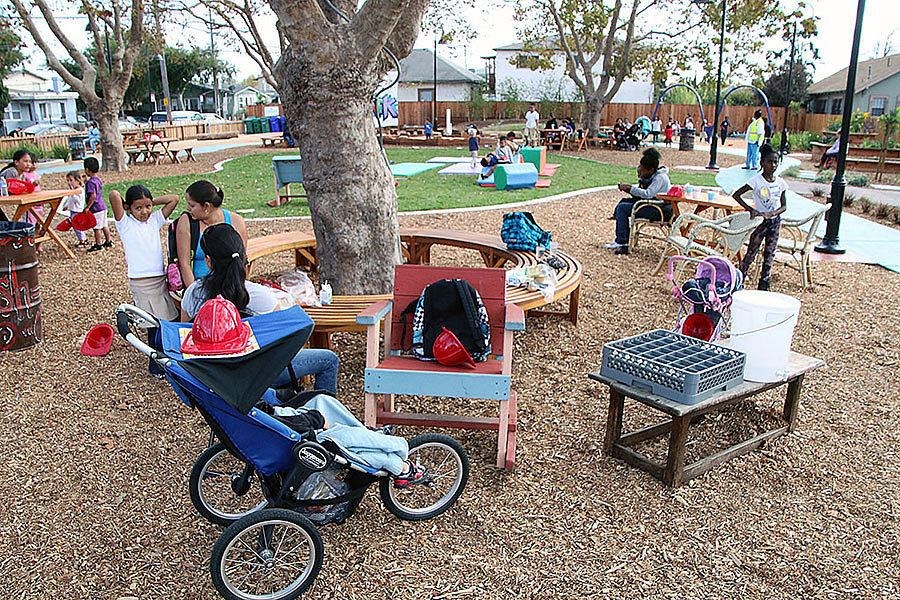 |
| Toody Maher is the executive director of Pogo Park, which has reimagined parkland. (Roger Cohn) |
Toody Maher is an urban visionary who helped residents in Richmond, Calif., collectively transform a deserted spot. She believes that the most beautiful and enlightened public spaces belong in the most disadvantaged communities.
MAY 24, 2017 RICHMOND, CALIF.—From their windows in the Iron Triangle section of Richmond, Calif. – a place synonymous with violence and urban blight – Rita Cerda and several other longtime residents watched as a crazy-seeming woman in pigtails poked around the then-deserted playground in their midst. Day after day in this heavily Latino and African-American neighborhood, she’d come to this sorry spot ridden with hypodermic needles and gin bottles, its swings shredded by pit bulls trained to improve their jaw strength by hanging from the seats.
“I’d be thinking, ‘What’s that white lady think she’s going to do in this neighborhood?” Ms. Cerda, who is Native American, recalls. “Everybody says they’re going to fix the park and nobody goes through with it.”
But as Cerda and her neighbors soon discovered, Toody Maher – the indefatigable force who helped them collectively transform that forlorn place into Pogo Park, one of the most innovative and jubilant public spaces in the United States – is definitely not everybody.
Ms. Maher, whose rubber gardening boots complement the yellow rubber bands fastened around the pigtails she still wears in her mid-50s, is an urban visionary – a playground-whisperer who stubbornly believes that the most beautiful and enlightened public spaces, especially playgrounds, not only belong in the most disadvantaged communities but also can be designed, built, managed, and programmed by the people who live there.
 |
| A child enjoys a swing at Pogo Park in Richmond, Calif. (photo: courtesy of Pogo Park) |
Her unusual first name – a childhood mispronunciation of “Susie” by her brother – seems fitting for a 6-foot-tall former businesswoman-turned-urban renegade who likens the process of creating a richly detailed park to cooking a slow and delectable soup. Pogo Park has been years in the making – it’s still simmering – and each tiny flourish, from hand-carved redwood benches to the cascading water that flows over rocks to mimic a mountain stream, profoundly reflects the spirit and place of its makers.
“You can’t microwave a park,” Maher observes of the time it takes to get it right. “Children’s play is a canary in a coal mine. If you want to see how a community is doing, look at its playgrounds.”
Citizen participation in playground design isn’t new. But the reimagining of Elm Playlot and a new sister park by a “team” of residents – with Maher as coach and provocateur in chief – has considerably upped the ante. Together, after seven years of meetings and learning how to weld, bend rebar, pour cement, and cajole local politicians, they have forged a dazzling oasis of calm and possibility in a neighborhood in which youngsters are frequently awakened by gunshots and more than a third of them live in poverty. The team’s motto? “Think it; do it.”
Named for three sets of historical railroad tracks that form its border, the Iron Triangle has struggled since the end of World War II, when Richmond’s mighty Kaiser Shipyards – home to thousands of “Rosie the Riveters” – closed down, leaving nearly half the population out of work, particularly African-Americans who had moved west to join the war effort.
 |
| Two boys play chess at Pogo Park in Richmond, Calif. (photo courtesy of Pogo Park) |
Today, a cornucopia of industrial pollutants buffets the neighborhood, creating unusually high asthma rates. And exposure to violence or the fear of it pervades the lives of children, plunging many into a constant state of stress.
Jason Corburn, a professor of planning and public health at the University of California, Berkeley, is beginning a study for the state of California to measure the effect of Pogo Park on the surrounding neighborhood. “Toody is not just about parks – she is a community builder,” Dr. Corburn observes. “Pogo Park is a heart that pumps life into the hardest-hit area of Richmond.”
The park has benefited from city policies that put health front and center in government decisionmaking, especially in land-use planning. It’s a recognition that there are steps a city can take to positively influence health, whether it’s planting more trees or installing streetlights to make neighborhoods safer.
Maher moved about a mile from the park with her partner in 2007. She was astonished to learn that although most kids in the Iron Triangle were stuck indoors, nearly a quarter of city-owned land was parks. “That’s a tremendous asset,” she observes. “But if you look at it from a business point of view, it was underperforming.”
 |
| This area in Richmond, Calif., was once ridden with hypodermic needles and gin bottles. Now Pogo Park is an oasis of calm and possibility. (photo: courtesy of Pogo Park) |
She visited all 56 parks. But her evolution from an entrepreneur heralded by Forbes and Inc. to a crusader bringing a Jardin du Luxembourg sensibility to the Iron Triangle wasn’t exactly a foregone conclusion. Yet her approach remains the same. “My blessing and my curse is that I can’t stand when things aren’t done right,” she says.
Her out-of-the-box mind-set was nurtured early on: Her British parents, whose green thumb she inherited, did not believe in television, preferring storytelling followed by a nightcap of charades. Her father’s job at a Brazilian airline allowed the family to travel the world. “Everyone else was watching ‘Adam-12’ and ‘The Waltons,’ but our parents gave everything to our experiences,” she says.
Raised in Montreal near the magnificent park on Mount Royal, and then outside Los Angeles, young Toody was teased relentlessly for a terrible stutter, sparking a deep sense of empathy for others in similar situations. But she was also a natural athlete with a persistent (some might say willful) streak; at age 12, she pushed to become the first girl on the boys’ Little League team. “My sister is the kind of person who works through three root canals,” observes her older brother, Adrian Maher.
In the 1980s they became brother-sister entrepreneurs, securing the Western distribution rights for Swatch watches before launching a company that produced a clear telephone with lights.
Ms. Maher’s plan was to accrue enough wealth to pursue her Frederick Law Olmsted-ish fantasy of building a great park. Her partner, Julie Roemer, a writer and teacher, finally asked: “What are you waiting for?” Maher was itching to upend the mass-produced, creativity-zapping play equipment that she calls “the tyranny of unrelenting sameness.”
Earning the community’s trust took years. “She was looking for some yokel-locals to help with the project,” recalls Carmen Lee, a revered neighborhood figure who was the first to come on board. “You know your community best,” Maher told them. “I’m a bridge with the Man,” as she calls the business establishment. “Let’s partner up.”
It was a modest start: a pop-up park consisting of a Home Depot fence, a cheap slide from Amazon, and a free shipping container. Maher savvily wired the park with free internet, bridging the digital divide and knitting wary neighbors together.
A core team of about a dozen residents went door to door soliciting ideas for the park, especially from children. No. 1 on the wish list was a zip line (done!). “The only thing we couldn’t deliver was a chocolate fountain,” says Tonie Lee, an original team member. Residents make full-scale mock-ups of their ideas, experimenting until it feels right.
Fortuitously, a company down the street, Scientific Art Studio, is a professional fabrication wizard that created the 26-foot-tall baseball glove at the San Francisco Giants ballpark. The studio has taken the team under its artful wing, helping craft igloo-shaped hide-outs and other never-before-seen play elements.
Maher may be happiest when pruning or going to the arborist to pick up mulch, but her business acumen has served Pogo Park well, including a recent $6.2 million grant from the state. She sets the bar high, bringing in innovative thinkers like Dan Burden, a widely respected street designer who is helping residents transform a bleak and dangerous thoroughfare into a lush, pedestrian-friendly “yellow brick road” linking schools and parks.
Maher has an eye for perfection – for perfect trees planted with perfect acorns – that members of the core team have inherited. They receive a salary to watch over the park, keep it spiffy, and organize daily activities, from hula hoop play to rock-balancing. The park also serves meals and snacks free of charge to children as an official distribution point for the school district (most kids qualify for free or reduced-price lunches). “Some are really hungry, sorry to say,” Carmen Lee says.
Flower memorials to youngsters killed in gun violence – two worked at the park – are reminders of the considerable challenges that remain in the Iron Triangle.
But on a warm afternoon in the dappled light under sycamores, the park’s role in the lives of neighborhood children was set off in bas-relief. Teens ate snacks on disc swings while a young girl waded barefoot in the pebbled stream. Perhaps the biggest gift Pogo Park offers children is the ability to put the world on hold for a time, to get lost in a daydream while skipping a stone in a brook.
“I’m glad we built this park,” Ms. Lee observes. “It wasn’t Toody opening a book. It came from the community – for the people, by the people, however you want to put it. It’s one place kids can come where it’s safe and they feel loved.”
Page created on 6/27/2017 1:38:23 PM
Last edited 6/27/2017 1:38:23 PM




